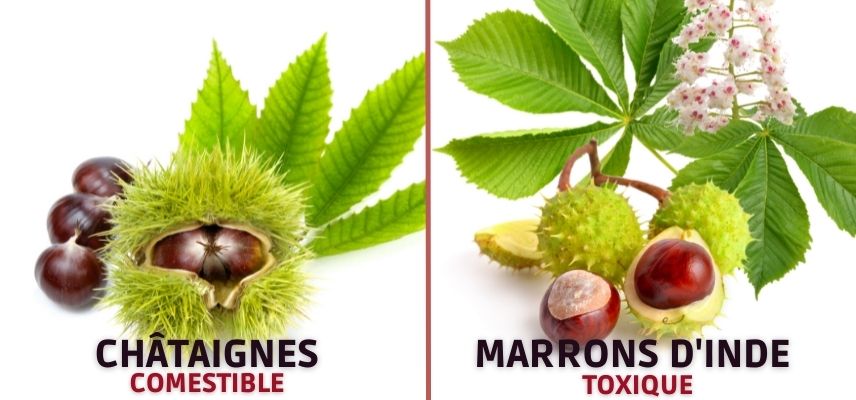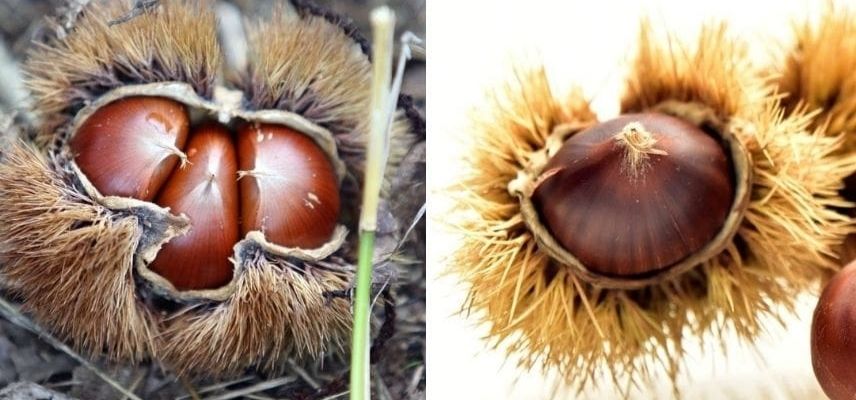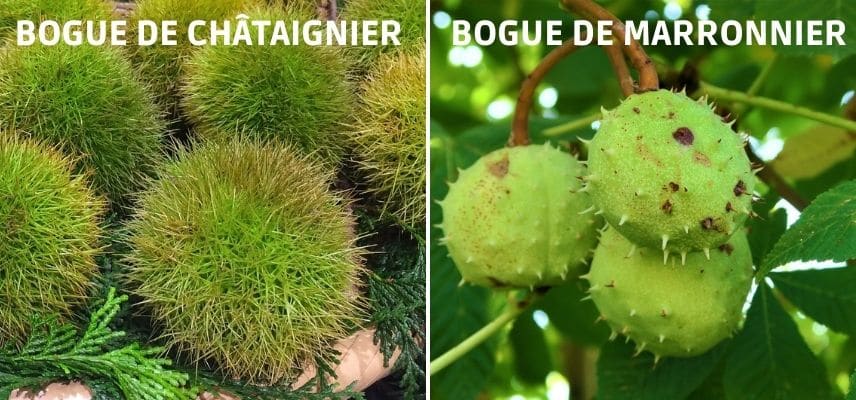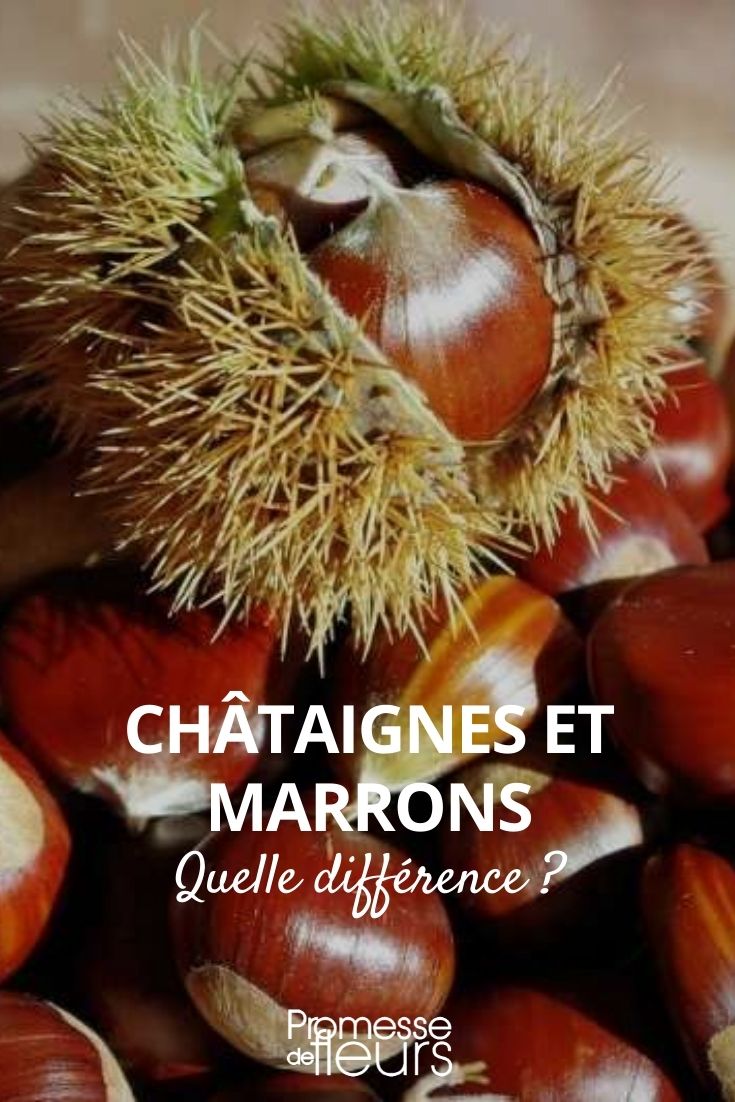
Chestnut and horse chestnut, what are the differences?
Learn to differentiate them to avoid mistakes
Contents
Autumn is the ideal season for gathering chestnuts. This small fruit from the chestnut tree, once known as the bread tree, can be enjoyed in many forms and recipes: roasted chestnuts, candied chestnuts, chestnut flour, chestnut cream, turkey with chestnuts, and many more! However, be careful! Do not confuse the chestnut, sometimes called “marron”, with the “horse chestnut”, the fruit of the inedible horse chestnut tree, which can be toxic. So how can you tell them apart? Chestnut, marron, and horse chestnut, we explain everything so you won’t get it wrong.

Why are chestnuts called "marrons"?
What do chestnut cream, roasted chestnuts, and turkey with chestnuts have in common? All these chestnuts are actually sweet chestnuts, a fruit from the botanical genus Castanea, from the family of Fagaceae.
To better understand, it is important to know that there are two types of sweet chestnuts :
- Wild varieties: the burr contains several small fruits known as sweet chestnuts. It is sometimes dissepimented. This is the case for Castanea sativa, commonly known as the sweet chestnut tree. This variety is the most widespread, and you will likely encounter it in the forest.
- Improved and cultivated varieties: the burr contains a single large sweet chestnut, non-dissepimented, which is botanically referred to as “marron”: such as the sweet chestnut tree Castanea sativa ‘Marron de Lyon’ and Castanea ‘Marigoule’. These varieties are primarily cultivated in chestnut groves for their good productivity and for the production of chestnut-based products.
The French term “marron” thus refers to a single, non-dissepimented sweet chestnut, which should not be confused with the “horse chestnut,” a fruit of the horse chestnut tree that is inedible.
 On the left: a burr and its wild sweet chestnuts. On the right: a burr and its single sweet chestnut, called “marron.”
On the left: a burr and its wild sweet chestnuts. On the right: a burr and its single sweet chestnut, called “marron.”
Read also
Harvesting and storing chestnutsIs the horse chestnut edible?
Unlike the chestnut from the sweet chestnut tree, the horse chestnut’s conkers are not edible and could even be toxic if ingested. They can cause digestive issues, nausea, as well as vomiting and sore throats.
The horse chestnut belongs to the genus Aesculus, in the family Sapindaceae, and produces the famous “horse chestnuts.” It does not belong to the same family as the sweet chestnut, with which it is often confused. According to the French Agency for Food, Environmental and Occupational Health & Safety (ANSES), confusions between horse chestnuts and sweet chestnuts account for 11% of all mix-ups across all seasons.
However, the horse chestnut has been used in pharmacopoeia since the 1960s for certain treatments. Laboratories report that they remove esculin, a component of the horse chestnut that is considered a toxic anticoagulant.
Note: in case of ingestion and poisoning, ANSES advises contacting a doctor or poison control centre promptly.

On the left: edible chestnuts. On the right: inedible horse chestnuts
The main differences between both
There are several elements that will help you distinguish between the fruit of the sweet chestnut tree and that of the horse chestnut tree. Here are a few.
The husks
Both chestnuts and horse chestnuts are covered by a protective shell: the husk. However, it differs between the two species.
- For sweet chestnuts: the husk is covered with very sharp, long, and closely spaced spines, resembling a small hedgehog. It is, in fact, difficult to handle.
- For horse chestnuts: the husk is thick with small, widely spaced, and less sharp spikes. It can be easily handled.

On the left chesnut husk, on the right horse chestnut husk
The foliage of the tree
- For the sweet chestnut: the leaves are alternate and have an elongated shape with serrated edges.
- For the horse chestnut: the leaves are composed of 5 to 7 leaflets, which are oblong or elliptical and serrated. The central leaflets are larger than the lateral ones. The leaf resembles the shape of a hand.

Left: chestnut leaves, and right : horse chestnut leaves
The shape of the seed
- For the sweet chestnut: the chestnut is brown to reddish-brown. Its base forms a light brown oval. On top, it has a small tuft known as a “torch.” It is rather triangular in shape, with one or two flattened sides. There are 2 to 3 chestnuts per husk.
- For the horse chestnut: the horse chestnut is shiny brown, except for its base, which forms a lighter circle, milky beige in colour. It is rounded in shape. Generally, there is only one horse chestnut per husk.

On the left, chestnuts and on the right horse chestnuts
Read also
The recipe for chestnut jamWhat can you do with chestnuts?
Chestnut is a food that can be cooked in a variety of ways. As an appetizer, starter, side dish, dessert, or confectionery. Here is a non-exhaustive list of recipe ideas, both sweet and savoury, featuring chestnuts and marrons:
- Chestnut purée to accompany meats during festive meals
- A stuffing for poultry, with chestnut and pork or game
- The famous hot marrons or roasted chestnuts: grill chestnuts in a pan over an open fire
- Chestnut flour (for making cakes, pancakes, as a partial substitute for wheat flour)
- Chestnut velouté with almond milk
- Chestnut and potimarron or pumpkin velouté
- Chestnut and foie gras velouté
- The famous candied marron
- In syrup
- The gourmet chestnut cream (or chestnut jam)
- A meat terrine with marrons
- A tiramisu with crushed marrons
For further reading
- To learn all about the chestnut tree, read our sheet: Chestnut Tree: planting, pruning and care
- Discover our tutorial and our recipe to make a delicious chestnut jam
- Read all our tips for harvesting and storing chestnuts
- Subscribe!
- Contents
































Comments